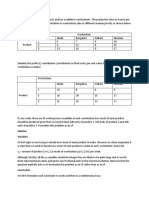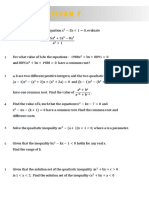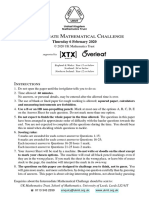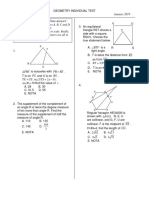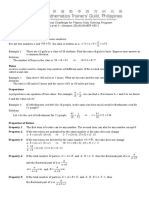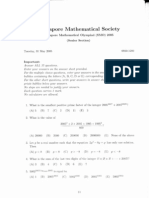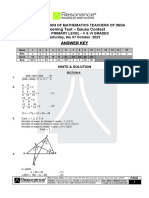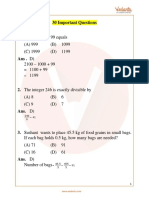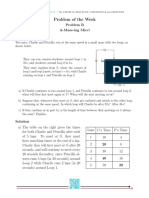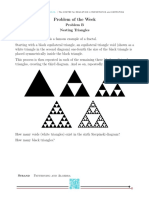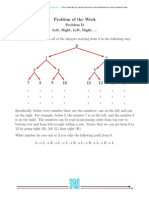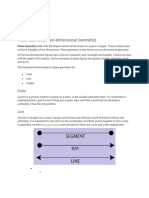2002 Gauss 8 Solution
2002 Gauss 8 Solution
Uploaded by
scribd-in-actionCopyright:
Available Formats
2002 Gauss 8 Solution
2002 Gauss 8 Solution
Uploaded by
scribd-in-actionOriginal Description:
Copyright
Available Formats
Share this document
Did you find this document useful?
Is this content inappropriate?
Copyright:
Available Formats
2002 Gauss 8 Solution
2002 Gauss 8 Solution
Uploaded by
scribd-in-actionCopyright:
Available Formats
Solutions
2002 Gauss Contest - Grade 8
Part A
1.
The value of
1
2
1
4
(A) 1
is
(B)
1
8
(C)
1
6
(D)
2
6
(E)
3
4
Solution
Using a common denominator,
1
2
2.
1
4
2
4
1
4
= 4.
ANSWER: (E)
The expression 6 1000 + 5 100 + 6 1 is equivalent to
(A) 656
(B) 6506
(C) 6056
(D) 60 506
(E) 6560
Solution
Expanding,
6 1000 + 5 100 + 6 1 = 6000 + 500 + 6 = 6506 .
3.
The value of 32 ( 4 2 ) is
(A) 4
(B) 17
(C) 1
ANSWER: (B)
(D) 2
(E) 0
Solution
By order of operations,
32 ( 4 2) = 9 ( 4 2) = 9 8 = 1 .
4.
ANSWER: (C)
An integer is divided by 7 and the remainder is 4. An example of such an integer is
(A) 14
(B) 15
(C) 16
(D) 17
(E) 18
Solution
Since 14 is a multiple of 7, then 18 (which is 4 more than 14) gives a remainder of 4 when divided
by 7.
ANSWER: (E)
5.
Which of the following expressions is equal to an odd integer?
(A) 3(5) + 1
(B) 2(3 + 5)
(C) 3(3 + 5)
(D) 3 + 5 + 1
(E)
(C) 3(3 + 5) = 24
(D) 3 + 5 + 1 = 9
(E)
3+5
2
Solution
Evaluating the choices,
(A) 3(5) + 1 = 16
(B) 2(3 + 5) = 16
Choice (D) gives the only odd integer.
9
3+5
=4
2
ANSWER: (D)
Solutions
2002 Gauss Contest - Grade 8
6.
Qaddama is 6 years older than Jack. Jack is 3 years younger than Doug. If Qaddama is 19 years old,
how old is Doug?
(A) 17
(B) 16
(C) 10
(D) 18
(E) 15
Solution
If Qaddama is 6 years older than Jack and she is 19 years old, then Jack is 13 years old. If Jack is
3 years younger than Doug, then Doug must be 16 years of age.
ANSWER: (B)
7.
The volume of a rectangular box is 144 cm 3 . If its length is 12 cm and its width is 6 cm, what is its
height?
(A) 126 cm
(B) 72 cm
(C) 4 cm
(D) 8 cm
(E) 2 cm
Solution
We know that Volume = Length Width Height , the volume is 144 cm 3, and
Length Width = 72 cm 2 . Thus, 144 cm 3 = 72 cm 2 Height , or Height = 2 cm .
ANSWER: (E)
8.
In a jar, the ratio of the number of oatmeal cookies to the number of chocolate chip cookies is 5:2. If
there are 20 oatmeal cookies, the number of chocolate chip cookies in the jar is
(A) 28
(B) 50
(C) 8
(D) 12
(E) 18
Solution
The ratio 5:2 indicates that there are 5 oatmeal cookies for every 2 chocolate chip cookies. Since
there are 20 oatmeal cookies, there are four groups of 5 oatmeal cookies. Thus there are 4 2 = 8
chocolate chip cookies.
Algebraically, we could let x represent the number of chocolate chip cookies. Then 5 : 2 = 20 : x ,
5 20
or = . If we want to write 5 as a fraction with a numerator of 20, we multiply both the nu2
2
x
5 5 4 20
= . Therefore, x = 8.
merator and denominator by 4, ie. =
ANSWER: (C)
2 24 8
9.
The bar graph shows the numbers of boys and girls in Mrs. Kuwabaras class. The percentage of
students in the class who are girls is
(A) 40%
(B) 15%
(C) 25%
(D) 10%
(E) 60%
Students in Mrs. Kuwabaras Class
Girls
Boys
1 2 3 4 5 6 7 8 9 10 11 12 13 14 15
Number of Students
10
Solutions
2002 Gauss Contest - Grade 8
Solution
From the graph, there are 10 girls and 15 boys in the class. Then, there are 25 students in total in
the class, so the percentage of girls is
10.
10
25
100% = 40%.
ANSWER: (A)
Which of the following statements is not true?
(A) A quadrilateral has four sides.
(B) The sum of the angles in a triangle is 180r.
(C) A rectangle has four 90r angles.
(D) A triangle can have two 90r angles.
(E) A rectangle is a quadrilateral.
Solution
A quadrilateral has four sides, by definition.
The sum of the angles in a triangle is 180o .
A rectangle has four 90o angles, by definition.
A rectangle is a quadrilateral, since it has four sides.
However, a triangle cannot have two 90o , since its three angles add to 180o , and its third angle
ANSWER: (D)
cannot be 0o .
Part B
11.
A palindrome is a positive integer whose digits are the same when read forwards or backwards. 2002
is a palindrome. What is the smallest number which can be added to 2002 to produce a larger
palindrome?
(A) 11
(B) 110
(C) 108
(D) 18
(E) 1001
Solution
The best way to analyze this problem is by asking the question, What is the next palindrome
bigger than 2002? Since the required palindrome should be of the form 2 aa 2 , where the middle
two digits (both a) do not equal 0, it must be the number 2112. Thus, the number that must be
added to 2002 is 2112 - 2002 = 110 .
ANSWER: (B)
12.
Which of the following can be folded along the lines to form a cube?
(A)
(B)
(C)
(D)
(E)
Solution
Only choice (D) can be folded to form a cube. (Try constructing these nets to check this answer.)
ANSWER: (D)
11
Solutions
2002 Gauss Contest - Grade 8
13. If a + b = 12, b + c = 16, and c = 7 , what is the value of a?
(A) 1
(B) 5
(C) 9
(D) 7
(E) 3
Solution
Since c = 7 and b + c = 16, then b + 7 = 16, or b = 9.
Since b = 9 and a + b = 12, then a + 9 = 12, or a = 3.
14.
ANSWER: (E)
In the diagram, ABD = BDC and DAB = 80r . Also,
AB = AD and DB = DC . The measure of BCD is
(A) 65r
(B) 50r
(C) 80r
(D) 60r
(E) 70r
A
80r
C
Solution
Since D ABD is isosceles, then ABD = ADB .
Therefore,
A
80r
80o + ABD + ADB = 180o
2 ABD = 100o (since ABD = ADB)
ABD = 50o
Thus, BDC = 50o as well, since ABD = BDC . Since
D BDC is also isosceles, then if we repeat a similar calculation to above, we obtain that BCD = 65o .
50r
50r
B 65r
50r
65r
C
ANSWER: (A)
15. A perfect number is an integer that is equal to the sum of all of its positive divisors, except itself. For
example, 28 is a perfect number because 28 = 1 + 2 + 4 + 7 + 14 . Which of the following is a perfect
number?
(A) 10
(B) 13
(C) 6
(D) 8
(E) 9
Solution
We must check each of the answers:
Number
Positive divisors
Sum of all positive divisors except itself
(A)
10
1, 2, 5, 10
1+ 2 + 5 = 8
(B)
13
1, 13
1
1+ 2 + 3 = 6
(C)
6
1, 2, 3, 6
1+ 2 + 4 = 7
(D)
8
1, 2, 4, 8
1+ 3 = 4
(E)
9
1, 3, 9
The only number from this set that is a perfect number is 6. (Note that the next two perfect
number bigger than 28 are 496 and 8128.)
Answer: (C)
12
Solutions
2002 Gauss Contest - Grade 8
16. Three pennies are flipped. What is the probability that they all land with heads up?
(A)
1
8
(B)
1
6
(C)
1
4
(D)
1
3
(E)
1
2
Solution
If we toss one penny, the probability that it lands with heads up is
1
.
2
Since we want three heads up, we must multiply these probabilities together. That is, the probability
is
1
2
2 2 = 8.
Alternatively, we could list all of the possibilities for the 3 pennies, using H to represent heads and
T to represent tails:
HHH
THH
HHT
THT
HTH
TTH
HTT
TTT
This means that there are 8 equally likely possibilities, one of which is the desired possibility.
Therefore, the probability of three heads coming up is 1 .
ANSWER: (A)
17. If P is a negative integer, which of the following is always positive?
1
(B)
(C) 2P
(D) P 1
(A) P 2
P
(E) P3
Solution
If we try P = -1,
1
(C) 2 P = -2
(D) P - 1 = -2
(E) P3 = -1
= -1
P
and so the only possibility for the correct answer is (A). (In fact, P 2 is always greater than or
equal to 0, regardless of the choice for P.)
ANSWER: (A)
(A) P 2 = 1
(B)
18. When expanded, the number of zeros in 100010 is
(A) 13
(B) 30
(C) 4
(D) 10
(E) 1000
Solution
Using exponent laws,
( )
100010 = 10 3
10
=10 310 =10 30
so if we were to write the number out in full, there should be 30 zeros.
ANSWER: (B)
13
Solutions
2002 Gauss Contest - Grade 8
y
19. The word stop starts in the position shown in the diagram
to the right. It is then rotated 180r clockwise about the
origin, O, and this result is then reflected in the x-axis.
Which of the following represents the final image?
stop
y
(A)
(B)
(C)
(D)
(E)
pots
O
stop
pots
pots
stop
Solution
If we start by rotating by 180o and then reflecting that image, we would get the following:
y
y
stop
stop
stop
pots
Rotation of 180o
Reflection in x-axis
ANSWER: (E)
20. The units digit (that is, the last digit) of 762 is
(A) 7
(B) 1
(C) 3
(D) 9
(E) 5
Solution
If we write out the first few powers of 7,
71 = 7, 7 2 = 49, 7 3 = 343, 7 4 = 2401, 7 5 = 16 807,K
we can see that the units digit follows the pattern 7, 9, 3, 1, 7, 9, 3, 1, 7, (That is to say, the units
digit of a product depends only on the units digits of the numbers being multiplied together. This tells
us that we only need to look at the units digit of the previous power to determine the units digit of a
given power.)
So the pattern 7, 9, 3, 1, repeats in blocks of four. Since 60 is a multiple of 4, this means that 760 has
a units digit of 1, and so 762 has a units digit of 9.
14
ANSWER: (D)
Solutions
2002 Gauss Contest - Grade 8
Part C
21.
A rectangle has sides of integer length (when measured in cm) and an area of 36 cm 2 . What is the
maximum possible perimeter of the rectangle?
(A) 72 cm
(B) 80 cm
(C) 26 cm
(D) 74 cm
(E) 48 cm
Solution
Since the area is 36 cm 2 and the sides have integer length, then we make a table of the possibilities:
Side lengths
Perimeter
1, 36
2(1 + 36) = 74
2, 18
2(2 + 18) = 40
3, 12
2(3 + 12) = 30
4, 9
2( 4 + 9) = 26
6, 6
2(6 + 6) = 24
So the maximum possible perimeter is 74 cm.
22.
ANSWER: (D)
If each diagonal of a square has length 2, then the area of the square is
(A) 1
(B) 2
(C) 3
(D) 4
Solution
We draw the square and its two diagonals.
The diagonals of a square cut each other into two equal parts,
and intersect at right angles. So we can decompose the
square into 4 identical triangles with base 1 and height 1. So
[ (1)(1)]=4[ ]=2 .
the area of the square is 4
1
2
1
2
(E) 5
ANSWER: (B)
23.
A map is drawn to a scale of 1:10 000 . On the map, the Gauss Forest occupies a rectangular region
measuring 10 cm by 100 cm. What is the actual area of the Gauss Forest, in km 2 ?
(A) 100
(B) 1 000 000
(C) 1000
(D) 1
(E) 10
Solution
The actual lengths of the sides of the Gauss Forest are 10 000 times the lengths of the sides on the map.
So the one side has length
10 000 10 cm = 100 000 cm = 1000 m = 1 km
and the other side has length
10 000 100 cm = 1 000 000 cm = 10 000 m = 10 km .
The actual area of the Gauss Forest is therefore 1 km 10 km = 10 km 2 .
ANSWER: (E)
15
Solutions
2002 Gauss Contest - Grade 8
24. Veronica has 6 marks on her report card.
The mean of the 6 marks is 74.
The mode of the 6 marks is 76.
The median of the 6 marks is 76.
The lowest mark is 50.
The highest mark is 94.
Only one mark appears twice and no mark appears more than twice.
Assuming all of her marks are integers, the number of possibilities for her second lowest mark is
(A) 17
(B) 16
(C) 25
(D) 18
(E) 24
Solution
Since the mode of Veronicas 6 marks is 76, and only one mark appears more than once (and no marks
appear more than twice), then two of the marks must be 76. This tells us that four of her marks were
50, 76, 76, 94.
Since the median of her marks is 76 and she has six marks in total (that is, an even number of marks),
then the two marks of 76 must be 3rd and 4th when the marks are arranged in increasing order.
Let the second lowest mark be M, and the second highest be N. So the second lowest mark M is between
(but not equal to) 50 and 76, and the second highest mark N is between (but not equal to) 76 and 94.
We still need to use the fact that the mean of Veronicas marks is 74, so
50 + M + 76 + 76 + N + 94
= 74
6
M + N + 296 = 444
M + N = 148
M = 148 - N (*)
We know already that M is one of 51 through 75, but the possibilities for N and the equation (*) restrict
these possibilities further.
Since N can be any of 77 through 93, there are exactly 17 possibilities for N. The largest value of M
corresponds to N = 77 (ie. M = 71) and the smallest value for M is when N = 93 (ie. M = 55 ). Thus
the possibilities for M are 55 through 71, ie. there are 17 possibilities in total for M, the second smallest
mark.
ANSWER: (A)
25.
Emily has created a jumping game using a straight row of floor tiles that she has numbered
1, 2, 3, 4, . Starting on tile 2, she jumps along the row, landing on every second tile, and stops on
the second last tile in the row. Starting from this tile, she turns and jumps back toward the start, this
time landing on every third tile. She stops on tile 1. Finally, she turns again and jumps along the row,
landing on every fifth tile. This time, she again stops on the second last tile. The number of tiles in
the row could be
(A) 39
(B) 40
(C) 47
(D) 49
(E) 53
16
Solutions
2002 Gauss Contest - Grade 8
Solution
Since Emily first starts on tile 2 and jumps on every second tile, then she lands only on even numbered
tiles. Since she stops on the second last tile, the total number of tiles is odd.
Next, Emily jumps back along the row by 3s and ends on tile 1. So every tile that she lands on this
time has a number which is 1 more than a multiple of 3 (eg. 1, 4, 7, etc.) So the second last tile has a
number that is 1 more than a multiple of 3. This tells us that the overall number of tiles in the row is
2 more than a multiple of 3.
These two conditions tell us that the total number of tiles cannot be 39, 40 or 49.
Lastly, Emily jumps by 5s along the row starting at 1. This says each tile that she lands on has a number
that is 1 more than a multiple of 5. By the same reasoning as above, the total number of tiles in the row
is 2 more than a multiple of 5.
Of the two remaining possibilities (47 and 53), the only one that satisfies this last condition is 47, and
so 47 satisfies all 3 of the required conditions.
(Work back through Emilys steps using the fact that she starts with 47 tiles to check that this does
work.)
ANSWER: (C)
17
2002 Gauss Contest - Grade 8
Solutions
You might also like
- A Company Makes Three Products and Has Available 4 WorkstationsDocument2 pagesA Company Makes Three Products and Has Available 4 WorkstationsVignesh Ayyathurai100% (1)
- B.Dasgupta Solutions PDFDocument56 pagesB.Dasgupta Solutions PDFAkshat RastogiNo ratings yet
- Part A: Solutions 2001 Gauss Contest - Grade 8Document8 pagesPart A: Solutions 2001 Gauss Contest - Grade 8สฮาบูดีน สาและNo ratings yet
- 2001Gauss7Solution PDFDocument10 pages2001Gauss7Solution PDFkarpeoNo ratings yet
- HCF N LCM Aptitude QuestionsDocument10 pagesHCF N LCM Aptitude QuestionsavNo ratings yet
- AMC 10 Contest B: Solutions PamphletDocument8 pagesAMC 10 Contest B: Solutions PamphletLan NguyenNo ratings yet
- 2007 SL 0910 EDocument10 pages2007 SL 0910 EPei JingNo ratings yet
- IMOK Booklet 2010Document20 pagesIMOK Booklet 2010Mehrdad AbutalebiNo ratings yet
- Intermediate Mathematical Challenge: Solutions and InvestigationsDocument21 pagesIntermediate Mathematical Challenge: Solutions and InvestigationsDoddy FeryantoNo ratings yet
- De HOMC 2006 2013Document35 pagesDe HOMC 2006 2013Ba SacNo ratings yet
- 2002 Amc 10Document5 pages2002 Amc 10inqu1ryNo ratings yet
- Math Competition 2008Document32 pagesMath Competition 2008Rusdin La EbaNo ratings yet
- Primary Math Challenge ArithmeticDocument28 pagesPrimary Math Challenge ArithmeticSadi SnmzNo ratings yet
- SMO 2007 Open SolutionDocument11 pagesSMO 2007 Open Solutionwmdsg100% (1)
- National Olympiad Practice 7Document2 pagesNational Olympiad Practice 7Erwin ElloNo ratings yet
- 88 Kangaroo PK 2005 BenjaminDocument4 pages88 Kangaroo PK 2005 BenjaminSJK(C) THUNG HONNo ratings yet
- Ecolier 2008 EnglishDocument4 pagesEcolier 2008 EnglishMuhammad Zaheer AnwarNo ratings yet
- Intermediate Mathematical Challenge: InstructionsDocument4 pagesIntermediate Mathematical Challenge: InstructionsdanielshiNo ratings yet
- S - Geom Indiv Eastside W AnsDocument10 pagesS - Geom Indiv Eastside W AnsJake ZengNo ratings yet
- SMO 2005 Senior SolutionDocument11 pagesSMO 2005 Senior SolutionwmdsgNo ratings yet
- Euclid Workshop SolutionsDocument5 pagesEuclid Workshop SolutionsVenkat VenkataramananNo ratings yet
- 2023 State Competition Solutions - 0Document10 pages2023 State Competition Solutions - 0Daniel BoenfieNo ratings yet
- 2014 Korea InternationalDocument11 pages2014 Korea InternationalRefeniaUsmanNo ratings yet
- Mathematics Practice Test 1Document12 pagesMathematics Practice Test 1riaramdial21No ratings yet
- X Maths Standard QP Set CDocument7 pagesX Maths Standard QP Set CXB 02 Gurusaran.VNo ratings yet
- Nimo 8 PDFDocument4 pagesNimo 8 PDFsamridh guptaNo ratings yet
- Berkeley Math CircleDocument2 pagesBerkeley Math Circlehuymai54c0% (1)
- Test PaperDocument24 pagesTest PaperRajalakshmiNo ratings yet
- 2015mockamc10 WithsolDocument9 pages2015mockamc10 Withsolapi-272546296No ratings yet
- China China Girls Math Olympiad 2008Document2 pagesChina China Girls Math Olympiad 2008PremMehtaNo ratings yet
- Level 2 (Session 2B) Ratios, Rates and ProportionDocument14 pagesLevel 2 (Session 2B) Ratios, Rates and ProportionMl Phil50% (2)
- SMO 2005 Senior QuestionDocument6 pagesSMO 2005 Senior Questionwmdsg0% (1)
- Question Booklet: Inter-School Mathematics Contest 2017 - Individual Event (Junior Section)Document9 pagesQuestion Booklet: Inter-School Mathematics Contest 2017 - Individual Event (Junior Section)Imam SyafiiNo ratings yet
- 2024 State Competition Sprint RoundDocument8 pages2024 State Competition Sprint Roundshimmiguel00No ratings yet
- Kangoeroe WizBRAIN 2015 EngelsDocument5 pagesKangoeroe WizBRAIN 2015 EngelserikatsmaNo ratings yet
- 2016 KadettDocument3 pages2016 KadettjnNo ratings yet
- GeometeryDocument28 pagesGeometerysaraswathiNo ratings yet
- Geometry (Volume of Composite Figure/Surfece Area)Document10 pagesGeometry (Volume of Composite Figure/Surfece Area)Erwin ElloNo ratings yet
- 2003 State Solutions PDFDocument11 pages2003 State Solutions PDFBalaji Pabbisetty0% (2)
- Gauss Contest: Grade 7Document68 pagesGauss Contest: Grade 7Ludwing SierraNo ratings yet
- VTAMPS 15 P6 Set 2 1Document26 pagesVTAMPS 15 P6 Set 2 1JOSE BENAVENTENo ratings yet
- 2014 12A Solutions - PDF, Filename 2014 12A SolutionsDocument10 pages2014 12A Solutions - PDF, Filename 2014 12A SolutionspawdowiakNo ratings yet
- JMC11Document2 pagesJMC11aa27965No ratings yet
- Euclid Contest: The Centre For Education in Mathematics and Computing Cemc - Uwaterloo.caDocument143 pagesEuclid Contest: The Centre For Education in Mathematics and Computing Cemc - Uwaterloo.catony dooNo ratings yet
- 2nd Pui ChingDocument48 pages2nd Pui ChingKeith AndulanNo ratings yet
- UKMT - SK - Senior Kangaroo Mathematical Challenge 2013 - QuestionsDocument4 pagesUKMT - SK - Senior Kangaroo Mathematical Challenge 2013 - QuestionsArsh TewariNo ratings yet
- Grade 5 Benjamin 1 Grade 5 PKDocument9 pagesGrade 5 Benjamin 1 Grade 5 PKMinh PhươngNo ratings yet
- SMO 2009 Senior SolutionDocument16 pagesSMO 2009 Senior Solutionwmdsg100% (1)
- SMO 2008 Junior SolutionDocument7 pagesSMO 2008 Junior Solutionwmdsg0% (1)
- The Basics: Twenty-Seven ProblemsDocument15 pagesThe Basics: Twenty-Seven ProblemskheyNo ratings yet
- Mathematics Olympiad Set 3Document35 pagesMathematics Olympiad Set 3Senthilnathan SomasundaramNo ratings yet
- Mock AMC BDocument4 pagesMock AMC BeisatoponNo ratings yet
- Wajo 19 QnsolnDocument13 pagesWajo 19 QnsolnSmpnsatubontang Kaltim100% (1)
- Primary 2023 ADocument6 pagesPrimary 2023 Aswarg1232172No ratings yet
- SMO 2007 Senior SolutionDocument12 pagesSMO 2007 Senior Solutionwmdsg50% (2)
- HOMC2018 Junior IndividualDocument5 pagesHOMC2018 Junior IndividualDangnguyen BuiNo ratings yet
- π sq.cm - π sq .cm. π sq.cm. π sq.cmDocument19 pagesπ sq.cm - π sq .cm. π sq.cm. π sq.cmWayne CasanovaNo ratings yet
- 2000 Solutions Cayley Contest: Canadian Mathematics CompetitionDocument13 pages2000 Solutions Cayley Contest: Canadian Mathematics Competitionสฮาบูดีน สาและNo ratings yet
- Intermediate Feb3Document9 pagesIntermediate Feb3Tirumala KollurNo ratings yet
- IMO Maths Important Questions Class 6Document13 pagesIMO Maths Important Questions Class 6Ravindra SinghNo ratings yet
- Cayley Contest: Canadian Mathematics CompetitionDocument5 pagesCayley Contest: Canadian Mathematics Competitionสฮาบูดีน สาและNo ratings yet
- Cayley Contest: Canadian Mathematics CompetitionDocument6 pagesCayley Contest: Canadian Mathematics CompetitioneilycNo ratings yet
- Potwb 17 Pa 04 SDocument1 pagePotwb 17 Pa 04 Sscribd-in-actionNo ratings yet
- Problem of The Week: Problem E and Solution Linked DigitsDocument1 pageProblem of The Week: Problem E and Solution Linked Digitsscribd-in-actionNo ratings yet
- Problem of The WeekDocument2 pagesProblem of The Weekscribd-in-actionNo ratings yet
- Potwb 17 DP 10 SDocument1 pagePotwb 17 DP 10 Sscribd-in-actionNo ratings yet
- Potwb 15 Pa 25 PDocument1 pagePotwb 15 Pa 25 Pscribd-in-actionNo ratings yet
- Problem of The Week: Strand Patterning and AlgebraDocument1 pageProblem of The Week: Strand Patterning and Algebrascribd-in-actionNo ratings yet
- Problem of The Week: WWW - Cemc.Uwaterloo - CaDocument1 pageProblem of The Week: WWW - Cemc.Uwaterloo - Cascribd-in-actionNo ratings yet
- Problem of The Week: WWW - Cemc.Uwaterloo - CaDocument1 pageProblem of The Week: WWW - Cemc.Uwaterloo - Cascribd-in-actionNo ratings yet
- Problem of The Week: WWW - Cemc.Uwaterloo - CaDocument1 pageProblem of The Week: WWW - Cemc.Uwaterloo - Cascribd-in-actionNo ratings yet
- Problem of The Week: WWW - Cemc.Uwaterloo - CaDocument1 pageProblem of The Week: WWW - Cemc.Uwaterloo - Cascribd-in-actionNo ratings yet
- Problem of The Week: WWW - Cemc.Uwaterloo - CaDocument1 pageProblem of The Week: WWW - Cemc.Uwaterloo - Cascribd-in-actionNo ratings yet
- Potwe 15 Ae GM NP 08 SDocument1 pagePotwe 15 Ae GM NP 08 Sscribd-in-actionNo ratings yet
- Potwd 15 NN Rs 07 SDocument2 pagesPotwd 15 NN Rs 07 Sscribd-in-actionNo ratings yet
- Problem of The Week: Strands Measurement, Data Management and ProbabilityDocument1 pageProblem of The Week: Strands Measurement, Data Management and Probabilityscribd-in-actionNo ratings yet
- Potwb 15 DP NN 02 PDocument1 pagePotwb 15 DP NN 02 Pscribd-in-actionNo ratings yet
- Problem of The Week: Strands Measurement, Patterning and AlgebraDocument1 pageProblem of The Week: Strands Measurement, Patterning and Algebrascribd-in-actionNo ratings yet
- Potwb 15 GS 08 PDocument2 pagesPotwb 15 GS 08 Pscribd-in-actionNo ratings yet
- Babylonian MathematicsDocument32 pagesBabylonian MathematicsKaeyTVNo ratings yet
- Laplace - Transform Anju BDocument25 pagesLaplace - Transform Anju BJyothi upadhyayNo ratings yet
- TRG P2 STPM 2023 (Skema)Document11 pagesTRG P2 STPM 2023 (Skema)DylanEngNo ratings yet
- Signals and Systems - Electronics and Communication Engineering - EC - GATE Syllabus, Paper Solution, Question AnswerDocument55 pagesSignals and Systems - Electronics and Communication Engineering - EC - GATE Syllabus, Paper Solution, Question AnswerdileepanmeNo ratings yet
- AcuSolve 2017.1 Training ManualDocument262 pagesAcuSolve 2017.1 Training ManualGonzalo MayorNo ratings yet
- Engineering Graphics 2110013: "GTU Previous Year MCQ"Document5 pagesEngineering Graphics 2110013: "GTU Previous Year MCQ"daivee kmNo ratings yet
- Form 3 Mathematics Chapter 1 (Indices) KSSMDocument2 pagesForm 3 Mathematics Chapter 1 (Indices) KSSMBONG TZER WEI MoeNo ratings yet
- TIMO Final 2020-2021 P5Document4 pagesTIMO Final 2020-2021 P5An NguyenNo ratings yet
- Lecture 2: Basics of Quantum Mechanics: Scribed By: Vitaly Feldman Department of Mathematics, MIT September 9, 2003Document3 pagesLecture 2: Basics of Quantum Mechanics: Scribed By: Vitaly Feldman Department of Mathematics, MIT September 9, 2003Kush Kumar SinghNo ratings yet
- Anti-Synchronization of The Bullard and Rikitake Dynamo Systems Via Nonlinear Active ControlDocument6 pagesAnti-Synchronization of The Bullard and Rikitake Dynamo Systems Via Nonlinear Active ControltheijesNo ratings yet
- Radius Diameter Whole Numbers 1Document2 pagesRadius Diameter Whole Numbers 1Sherwin Phillip ArnucoNo ratings yet
- Lam MasterTechWiskDocument55 pagesLam MasterTechWiskVinay GuptaNo ratings yet
- Skills in Mathematics Differential Calculus For JEE Main and Advanced 2022Document561 pagesSkills in Mathematics Differential Calculus For JEE Main and Advanced 2022Harshil Nagwani88% (8)
- Linear Programming Problems The Simplex Method: Dr. Siddhalingeshwar I.GDocument27 pagesLinear Programming Problems The Simplex Method: Dr. Siddhalingeshwar I.GPraveenNo ratings yet
- Three Circles of Radius 5 CM Each, Touch Each Other. If The Points of Contact Are P, Q and R, Then What Is - Brainly - inDocument1 pageThree Circles of Radius 5 CM Each, Touch Each Other. If The Points of Contact Are P, Q and R, Then What Is - Brainly - infpyh5x66k7No ratings yet
- Math 5-Plane and Solid Geometry-Research - Bsed 2d-EscañoDocument35 pagesMath 5-Plane and Solid Geometry-Research - Bsed 2d-EscañoJulie Anne Ponteres EscañoNo ratings yet
- Saalfeld AutoCarto2012Document12 pagesSaalfeld AutoCarto2012mickamalNo ratings yet
- Maths Mania # 059: DIRECTIONS: For The Following Questions, Four Options Are Given. Choose The Correct OptionDocument3 pagesMaths Mania # 059: DIRECTIONS: For The Following Questions, Four Options Are Given. Choose The Correct OptionTUSHAR JALANNo ratings yet
- DLL - Mathematics 6 - Q3 - W2Document10 pagesDLL - Mathematics 6 - Q3 - W2Elona Jane CapangpanganNo ratings yet
- 4.trigonometric Ratio BMS K SchemeDocument73 pages4.trigonometric Ratio BMS K SchemeAisha MemonNo ratings yet
- Fractal Behavior of The Earth System - DimriDocument218 pagesFractal Behavior of The Earth System - Dimrialeyda_lenovo1100% (1)
- 4 Normal and Binomial Distribution 2021Document45 pages4 Normal and Binomial Distribution 2021Haikal DinieNo ratings yet
- Baltic Way 2016 - SolutionsDocument10 pagesBaltic Way 2016 - SolutionsgeorgeNo ratings yet
- Convolutional NetworksDocument25 pagesConvolutional NetworksIlya KavalerovNo ratings yet
- D3 Simplifying and Solving Quadratic Equations Notes (2020)Document2 pagesD3 Simplifying and Solving Quadratic Equations Notes (2020)Ella JudenNo ratings yet
- Mathsgenie - Co.uk Mathsgenie - Co.uk Please Do Not Write On This SheetDocument2 pagesMathsgenie - Co.uk Mathsgenie - Co.uk Please Do Not Write On This SheetYousif Jamal Al Naqbi 12BENo ratings yet
- 07 Similarity and Enlargement + Mixed Exe 1 PDFDocument32 pages07 Similarity and Enlargement + Mixed Exe 1 PDFDasoNo ratings yet
- Chapter-1 VectorsDocument6 pagesChapter-1 VectorsMd Najmul HudaNo ratings yet
